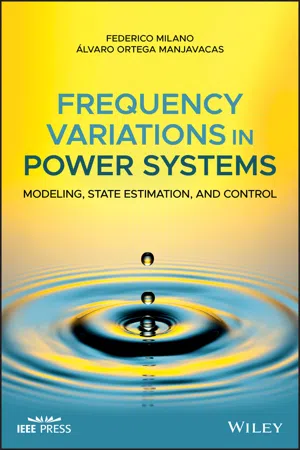
Frequency Variations in Power Systems
Modeling, State Estimation, and Control
- English
- ePUB (mobile friendly)
- Available on iOS & Android
Frequency Variations in Power Systems
Modeling, State Estimation, and Control
About This Book
Frequency Variations in Power Systems: Modeling, State Estimation and Control presents the Frequency Divider Formula (FDF); a unique approach that defines, calculates and estimates the frequency in electrical energy systems. This authoritative book is written by two noted researchers on the topic. They define the meaning of frequency of an electrical quantity (such as voltage and current) in non-stationary conditions (for example the frequency is not equal to the nominal one) and pose the foundation of the frequency divider formula. The book describes the consequences of using a variable frequency in power system modelling and simulations, in state estimation and frequency control applications.
In addition, the authors include a discussion on the applications of the frequency divider in systems where part of the generation is not based on synchronous machines, but rather on converter-interfaced energy resources, such as wind and solar power plants. This important book:
- Offers a review that clearly defines and shows how the Frequency Divider Formula can be applied
- Discusses the link between frequency and energy in power systems
- Presents a unified vision that accurately reveals the common thread that links modelling, control and estimation
- Includes information on the many implications that "local frequency variations" have on power system dynamics and control
- Contains several numerical examples
Written for researchers, academic staff members, students, specialised consultants and professional software developers, Frequency Variations in Power Systems questions the conventional transient stability model of power system and proposes a new formulation.
Frequently asked questions
Information
Part I
Background
Chapter 1
Frequency in Power Systems
1.1. Conventional Definitions






Table of contents
- Cover
- Table of Contents
- List of Figures
- List of Tables
- Preface
- Acknowledgments
- Acronyms and Abbreviations
- Notation
- Part I: Background
- Part II: Theory
- Part III: Applications
- Appendices
- Bibliography
- Index
- End User License Agreement